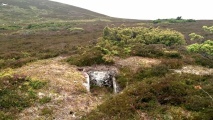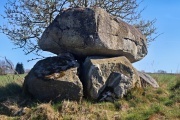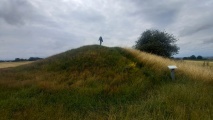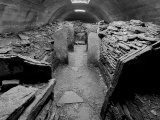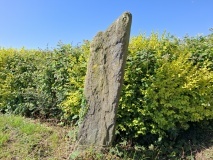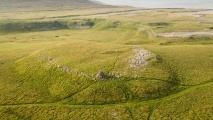Andy Burnham's Blog, page 13
August 8, 2025
Dolmen del Mas de la Mata
This dolmen, like the others in this Cataluñian valley was very difficult to find, even with an advanced GPS. All paths that were once in the area are overgrown with sharp, thorny bushes and are easily lost amongst boulders, trees, drops and slopes. It was a very difficult and sunny descent. Still, the dolmens are pleasing, and bold, red on white signs can be seen on arrival. This is useful as the bushes seem rampant. There are pairs of stacked stones left by someone who occasionally visits some of these sites. Expect a difficult scrabble if you visit, bring water and tell someone where you are heading. it is real ankle breaking terrain.
Published on August 08, 2025 13:42
August 7, 2025
Caerleon Roman Amphitheatre
The most complete Roman amphitheatre in the UK built around AD 90 just outside the Legio II Augusta fortress at Caerleon (Isca) to entertain and train the legionaries stationed there. Very impressive to this day, large enough to accommodate 6000 people on wooden stands built above the existing stone and earth base. It has two big entrances (Portae Pompae) through which the participants would enter, with six smaller entrances with steps up to the terracing for the audience.
Published on August 07, 2025 12:54
August 6, 2025
Tom na Moine
Woodend cairn, of national importance as a well-preserved example of a largely undisturbed Bronze Age burial cairn with central stone-lined cist. A low rising mound located 455m above sea level on the southern slopes of Tom na Moine. The burial chamber faces west-east with impressive views over the valley of the River Findhorn.
Published on August 06, 2025 07:25
Clach an t-Sagairt (Clachan Sands)
The Priests' Stone in English. A huge upright slab of Lewisian gneiss inscribed with a crude Latin cross. In Clachan Sands, a hamlet in the NE of North Uist.
Published on August 06, 2025 07:21
Herlufmagle Jættestue 1
A dolmen on a mound in Præstø, Denmark. The chamber has 3 orthostats (upright stones) and one capstone. There are cup marks on some of the stones. The mound is 9 meters wide by 1m tall with a second more ruinous tomb close by.
Published on August 06, 2025 07:14
August 5, 2025
Hellig Anders Høj
Hellig Anders Høj (also known as Korshøj or Hvilehøj) is a burial mound near Slagelse (Sjælland), which is also associated with a legend about the priest Anders. He was a priest in Slagelse in the 13th century. Folklore tells of his pilgrimage to Jerusalem. A cross was erected on the mound in his memory. There is a lot of superstition associated with this cross, which is why it has been renewed several times. Most recently in 1952, when a copy of the 18th century cross was made.
Published on August 05, 2025 12:48
Gun End of Base
A memorial to William Mudge and his triangulation of Britain, forming the baseline of the Ordnance Survey. At this point beside the A345 in Wiltshire is a cannon positioned vertically in the ground, which formed one end of the triangulation baseline made here in June 1794. This large inscribed stone was erected in 1967. The inscription reads "In 1794 a line from this site to Beacon Hill was measured by Capt W Mudge of the Ordnance Survey as a base for the triangulation of Great Britain."
Published on August 05, 2025 12:42
Knowe of Yarso
This 4900 year old stalled cairn sits above Eynhallow Sound on a continuation of the ridge below the uplands on the south side of Rousay island. The chamber is divided into stalls by vertical flagstones whilst the retaining walls comprise two layers of stonework, one on top of the other in a local tradition of a double skin of stone around the chamber. The stonework reflects the local Unstan Ware pottery's decoration tradition of triangular motifs. When excavated in 1934 the remains of at least 29 adults were found although for 17 only the skulls were found. The bones were disarticulated and arranged neatly in groups facing inwards.
Published on August 05, 2025 12:36
August 4, 2025
Menhir de Kerhuon
In Finistère, near the village of Quéménéven - what a beauty! Discovered in the 1960s during ploughing and reportedly 4 metres long in total. Re-erected at the entrance to the farm. At present it must measure about 2 m tall so we assume there is another 2m in the ground!
Published on August 04, 2025 15:35
August 1, 2025
Dudderhouse Hill
The Dudderhouse Hill long cairn has been designated a Scheduled Monument - the highest level of heritage protection available in England. The long cairn survives as a partly turf-covered oval mound of stones, about 23m (75ft) long, 12m (39m) wide and 1m (3ft) high.
"It doesn't look particularly impressive and that's one of the problems," Paul Jeffery, Historic England's national listings manager, said. "Nearby, about 70m (230ft) away, there's a cairn where people have added stones over time. Unfortunately, because they don't realise that this is such an important site, some people walking past pick up stones from what they think is just this pile and then add them to the other cairn and obviously that causes harm."
"It doesn't look particularly impressive and that's one of the problems," Paul Jeffery, Historic England's national listings manager, said. "Nearby, about 70m (230ft) away, there's a cairn where people have added stones over time. Unfortunately, because they don't realise that this is such an important site, some people walking past pick up stones from what they think is just this pile and then add them to the other cairn and obviously that causes harm."
Published on August 01, 2025 09:15



